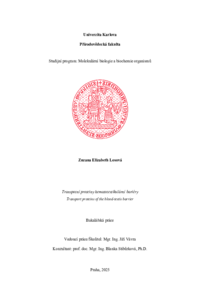Transportní proteiny hematotestikulární bariéry
Transport proteins of the blood-testis barrier
bachelor thesis (DEFENDED)

View/
Permanent link
http://hdl.handle.net/20.500.11956/199375Identifiers
Study Information System: 273704
Collections
- Kvalifikační práce [20861]
Author
Advisor
Consultant
Stibůrková, Blanka
Referee
Mančíková, Andrea
Faculty / Institute
Faculty of Science
Discipline
Molecular Biology and Biochemistry of Organisms
Department
Department of Cell Biology
Date of defense
29. 5. 2025
Publisher
Univerzita Karlova, Přírodovědecká fakultaLanguage
Czech
Grade
Excellent
Keywords (Czech)
Hematotestikulární bariéra, testes, Sertoliho buňky, epiteliální transport, ABC, SLC, transportní proteinyKeywords (English)
Blood-testis barrier, testes, Sertoli cells, epithelial transport, ABC, SLC, transport proteinsHematotestikulární bariéra představuje jednu z nejvýznamnějších fyziologických bariér v lidském organismu. Je tvořena mezibuněčnými spoji mezi Sertoliho buňkami v semenotvorných kanálcích varlat a striktně reguluje přechod látek mezi krví a adluminálním kompartmentem. Svou funkcí zajišťuje chráněné a specializované prostředí, nezbytné pro správný průběh spermatogeneze. Vysoká selektivita a těsnost hematotestikulární bariéry efektivně brání průniku škodlivých látek, patogenů i imunitních buněk, což sice chrání zárodečné buňky, ale zároveň představuje překážku pro vstup mnoha fyziologicky významných molekul, jako jsou aminokyseliny, proteiny a ionty. Z tohoto důvodu je pro zachování funkční integrity varlat a vývoj zárodečných buněk nezbytná přítomnost specifických transportních mechanismů. Významnou roli hrají ABC a SLC transmembránové transportní proteiny, umožňující regulovaný a selektivní přenos látek, a tím významně přispívají k udržení homeostázy testikulárního prostředí. Detailní porozumění jejich expresi, funkci a regulaci je zásadní nejen pro pochopení fyziologie mužského reprodukčního systému, ale i pro vývoj efektivních terapeutických strategií a cíleného transportu léčiv přes hematotestikulární bariéru. Klíčová slova Hematotestikulární bariéra, testes, Sertoliho buňky, epiteliální...
The blood-testis barrier represents one of the most important physiological barriers in the human body. It is formed by intercellular junctions between Sertoli cells within the seminiferous tubules of the testes and strictly regulates the passage of compounds between the bloodstream and the adluminal compartment of the testis. Through its function, it provides a protected and specialized environment essential for the proper progression of spermatogenesis. Its high selectivity and tightness effectively prevents the entry of harmful substances, pathogens, and immune cells, which protects germ cells, however it also poses a significant limitation for the entry of many physiologically important molecules, such as amino acids, proteins and ions. Therefore, the presence of specific transport mechanisms is crucial for maintaining the functional integrity of the testes and for supporting germ cell development. ABC and SLC transmembrane transport proteins play a significant role, enabling regulated and selective transfer of substances, thereby contributing to the maintenance of the testicular homeostasis. A detailed understanding of their expression, function, and regulation is essential not only for understanding the physiology of the male reproductive system but also for developing effective therapeutic...
